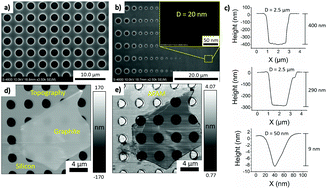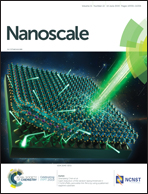Investigating the detection limit of subsurface holes under graphite with atomic force acoustic microscopy†
Abstract
The subsurface imaging capabilities of atomic force acoustic microscopy (AFAM) was investigated by imaging graphite flakes suspended over holes in a silicon dioxide substrate. The graphite thickness and the hole size were varied to determine the detection limit on the maximum graphite thickness and the smallest detectable hole size. Parameters including operating frequency, eigenmode, contact force, and cantilever stiffness were investigated for their influence of defect detection. AFAM was reliably able to detect 2.5 μm diameter holes through a maximum graphite thickness of 570 nm and sub 100 nm holes through 140 nm of graphite. The smallest detectable defect size was a 50 nm hole covered by an 80 nm thick graphite flake. Increasing the graphite thickness and decreasing the hole size both resulted in a decrease in subsurface contrast. However, the non-linear trend observed from increasing the graphite thickness indicates thickness has a greater effect on subsurface defect detection than variations in defect size. Through investigating various parameters, we have found certain cases to increase the observed contrast of the embedded subsurface holes, however the smallest detectable defect size remained the same. This technique's ability to reveal sub 100 nm defects buried under graphite has previously only been demonstrated in much softer polymer systems.



 Please wait while we load your content...
Please wait while we load your content...